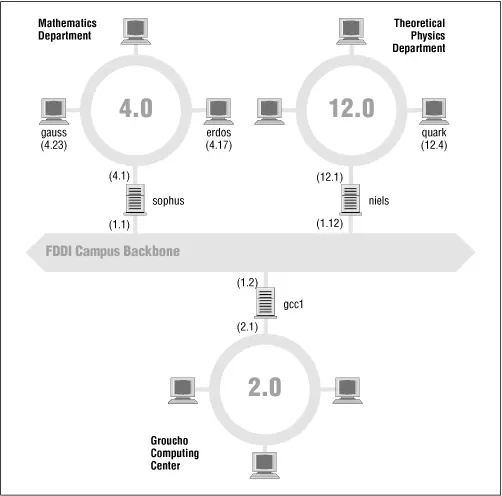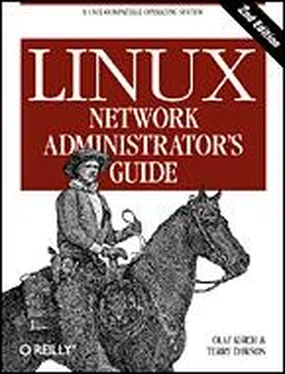IP networks are structured similarly. The whole Internet consists of a number of proper networks, called autonomous systems . Each system performs routing between its member hosts internally so that the task of delivering a datagram is reduced to finding a path to the destination host's network. As soon as the datagram is handed to any host on that particular network, further processing is done exclusively by the network itself.
This structure is reflected by splitting IP addresses into a host and network part, as explained previously. By default, the destination network is derived from the network part of the IP address. Thus, hosts with identical IP network numbers should be found within the same network. [15] Autonomous systems are slightly more general. They may comprise more than one IP network.
It makes sense to offer a similar scheme inside the network, too, since it may consist of a collection of hundreds of smaller networks, with the smallest units being physical networks like Ethernets. Therefore, IP allows you to subdivide an IP network into several subnets .
A subnet takes responsibility for delivering datagrams to a certain range of IP addresses. It is an extension of the concept of splitting bit fields, as in the A, B, and C classes. However, the network part is now extended to include some bits from the host part. The number of bits that are interpreted as the subnet number is given by the so-called subnet mask , or netmask . This is a 32-bit number too, which specifies the bit mask for the network part of the IP address.
The campus network of Groucho Marx University is an example of such a network. It has a class B network number of 149.76.0.0 , and its netmask is therefore 255.255.0.0 .
Internally, GMU's campus network consists of several smaller networks, such various departments' LANs. So the range of IP addresses is broken up into 254 subnets, 149.76.1.0 through 149.76.254.0 . For example, the department of Theoretical Physics has been assigned 149.76.12.0 . The campus backbone is a network in its own right, and is given 149.76.1.0 . These subnets share the same IP network number, while the third octet is used to distinguish between them. They will thus use a subnet mask of 255.255.255.0 .
Figure 2.1 shows how 149.76.12.4 , the address of quark , is interpreted differently when the address is taken as an ordinary class B network and when used with subnetting.
Figure 2.1: Subnetting a class B network

It is worth noting that subnetting (the technique of generating subnets) is only an internal division of the network. Subnets are generated by the network owner (or the administrators). Frequently, subnets are created to reflect existing boundaries, be they physical (between two Ethernets), administrative (between two departments), or geographical (between two locations), and authority over each subnet is delegated to some contact person. However, this structure affects only the network's internal behavior, and is completely invisible to the outside world.
Subnetting is not only a benefit to the organization; it is frequently a natural consequence of hardware boundaries. The viewpoint of a host on a given physical network, such as an Ethernet, is a very limited one: it can only talk to the host of the network it is on. All other hosts can be accessed only through special-purpose machines called gateways . A gateway is a host that is connected to two or more physical networks simultaneously and is configured to switch packets between them.
Figure 2.2 shows part of the network topology at Groucho Marx University (GMU). Hosts that are on two subnets at the same time are shown with both addresses.
Figure 2.2: A part of the net topology at Groucho Marx University

Different physical networks have to belong to different IP networks for IP to be able to recognize if a host is on a local network. For example, the network number 149.76.4.0 is reserved for hosts on the mathematics LAN. When sending a datagram to quark , the network software on erdos immediately sees from the IP address 149.76.12.4 that the destination host is on a different physical network, and therefore can be reached only through a gateway ( sophus by default).
sophus itself is connected to two distinct subnets: the Mathematics department and the campus backbone. It accesses each through a different interface, eth0 and fddi0 , respectively. Now, what IP address do we assign it? Should we give it one on subnet 149.76.1.0 , or on 149.76.4.0 ?
The answer is: "both." sophus has been assigned the address 149.76.1.1 for use on the 149.76.1.0 network and address 149.76.4.1 for use on the 149.76.4.0 network. A gateway must be assigned one IP address for each network it belongs to. These addresses - along with the corresponding netmask - are tied to the interface through which the subnet is accessed. Thus, the interface and address mapping for sophus would look like this:
| Interface |
Address |
Netmask |
| eth0 |
149.76.4.1 |
255.255.255.0 |
| fddi0 |
149.76.1.1 |
255.255.255.0 |
| lo |
127.0.0.1 |
255.0.0.0 |
The last entry describes the loopback interface lo , which we talked about earlier.
Generally, you can ignore the subtle difference between attaching an address to a host or its interface. For hosts that are on one network only, like erdos , you would generally refer to the host as having this-and-that IP address, although strictly speaking, it's the Ethernet interface that has this IP address. The distinction is really important only when you refer to a gateway.
We now focus our attention on how IP chooses a gateway to use to deliver a datagram to a remote network.
We have seen that erdos , when given a datagram for quark , checks the destination address and finds that it is not on the local network. erdos therefore sends the datagram to the default gateway sophus , which is now faced with the same task. sophus recognizes that quark is not on any of the networks it is connected to directly, so it has to find yet another gateway to forward it through. The correct choice would be niels , the gateway to the Physics department. sophus thus needs information to associate a destination network with a suitable gateway.
IP uses a table for this task that associates networks with the gateways by which they may be reached. A catch-all entry (the default route ) must generally be supplied too; this is the gateway associated with network 0.0.0.0 . All destination addresses match this route, since none of the 32 bits are required to match, and therefore packets to an unknown network are sent through the default route. On sophus , the table might look like this:
| Network |
Netmask |
Gateway |
Interface |
| 149.76.1.0 |
255.255.255.0 |
- |
fddi0 |
| 149.76.2.0 |
255.255.255.0 |
149.76.1.2 |
fddi0 |
| 149.76.3.0 |
255.255.255.0 |
149.76.1.3 |
fddi0 |
| 149.76.4.0 |
255.255.255.0 |
- |
eth0 |
| 149.76.5.0 |
255.255.255.0 |
149.76.1.5 |
fddi0 |
| … |
… |
… |
… |
| 0.0.0.0 |
0.0.0.0 |
149.76.1.2 |
fddi0 |
If you need to use a route to a network that sophus is directly connected to, you don't need a gateway; the gateway column here contains a hyphen.
Читать дальше





![Andrew Radford - Linguistics An Introduction [Second Edition]](/books/397851/andrew-radford-linguistics-an-introduction-second-thumb.webp)








